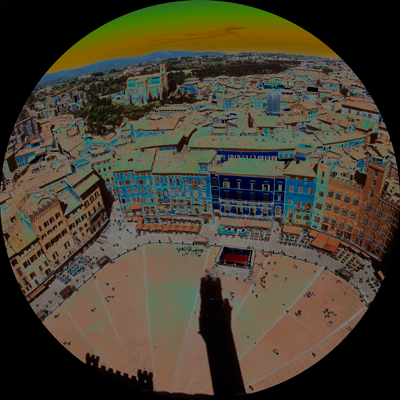Creative use of slow shutter speeds is perhaps the simplest special effect available to a travel photographer. Landscapes often benefit from the use of slow shutter speeds to blur moving water and give a gentle flowing feel to the image. Try speeds between 1/15 sec and 1 second depending on the rate of flow of the water and the effect required. Light trails created at night by moving vehicles, funfairs or fireworks can also be effective. Try exposures of several seconds or even a couple of minute to spread the coloured trails around the image and create interesting shapes.
 Another useful technique is to superimpose numerous similar images of the same subject in a single frame. For example, capture eight images of gently-moving wild flowers without advancing the film. The result should be a soft impressionist-style image conveying the feel as well as the appearance of the meadow. The exposure for each image must of course be set to one eighth of the required total exposure – ie reduced by three stops.
Another useful technique is to superimpose numerous similar images of the same subject in a single frame. For example, capture eight images of gently-moving wild flowers without advancing the film. The result should be a soft impressionist-style image conveying the feel as well as the appearance of the meadow. The exposure for each image must of course be set to one eighth of the required total exposure – ie reduced by three stops.
In addition to the normal UV or skylight filters, polarizers and sets of graduated neutral density filters, there are a number of special effects filters that can be useful when travelling. These include soft-focus, star burst, diffraction and multiple-image types. However, these should not be overused, and more exotic types are of limited value. Viewers might be amazed when they first see a photograph acquired using a multiple-image filter, but the novelty wears off quickly when repeated.
Coloured filters can be used to strengthen nature’s contribution. The best results are achieved when it is not apparent to the viewer that a filter has been used. A close-up of a leaf might be given more impact by using a green filter, or a sunset might be improved by using an 81B or orange filter. Coloured graduated filters, particularly those with natural colours, can also be useful. Use them in a subtle manner to enhance what nature provides, and the results can be truly amazing. Abuse them, perhaps by imposing garish coloured skies on a daylight image, and end up with nothing worthwhile.
Digital manipulation has of course had a significant impact on the creative use of special effects. The range of possibilities has increased and specialized darkroom effects can now be achieved quite simply using a computer. Almost anything is possible, and the work can be undertaken at a later date in the comfort of your own home. Travel photographers can now remove unwanted people or objects from their images, change colours, contrast and brightness, and correct converging verticals. They can also apply special effects filters to produce painterly effects to produce images in the style of watercolours or impressionist paintings.






